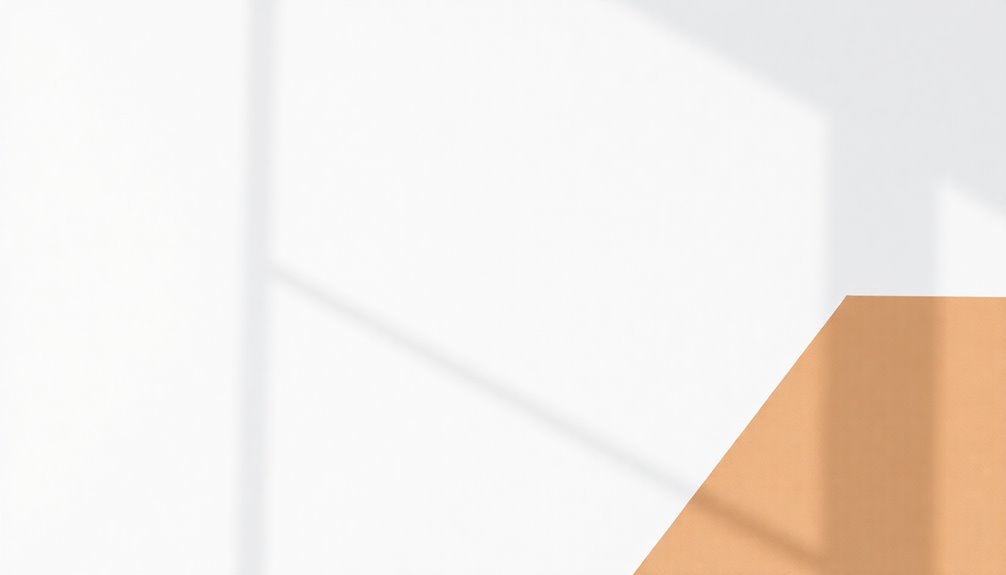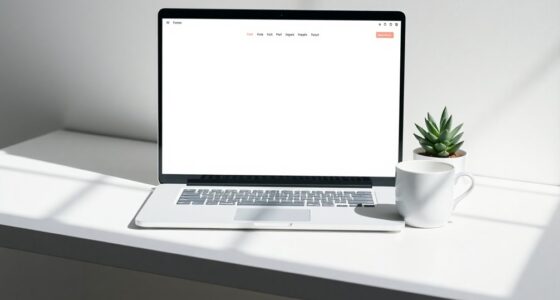Minimalist typography is gaining traction as it emphasizes clarity and simplicity in design. You'll notice clean lines, ample white space, and sans-serif fonts creating a more effective communication experience. This design approach enhances readability and reduces visual clutter, making information easier to digest. Users appreciate a streamlined navigation experience that feels intuitive. As this trend evolves, there's much more to explore about its impact and future directions in the world of design.
Key Takeaways
- Minimalist typography emphasizes clean lines and ample white space, enhancing readability and user experience across various devices.
- Its focus on clarity and simplicity effectively communicates messages, making it increasingly popular in modern design.
- The rise of digital platforms has fueled the demand for minimalist designs that streamline navigation and reduce visual clutter.
- Brands are adopting minimalist typography to foster professionalism and trust, enhancing emotional connections with their audience.
- Future trends indicate a shift towards adaptive typography and sustainable practices, further solidifying its relevance in contemporary design.
Definition and Characteristics of Minimalist Typography
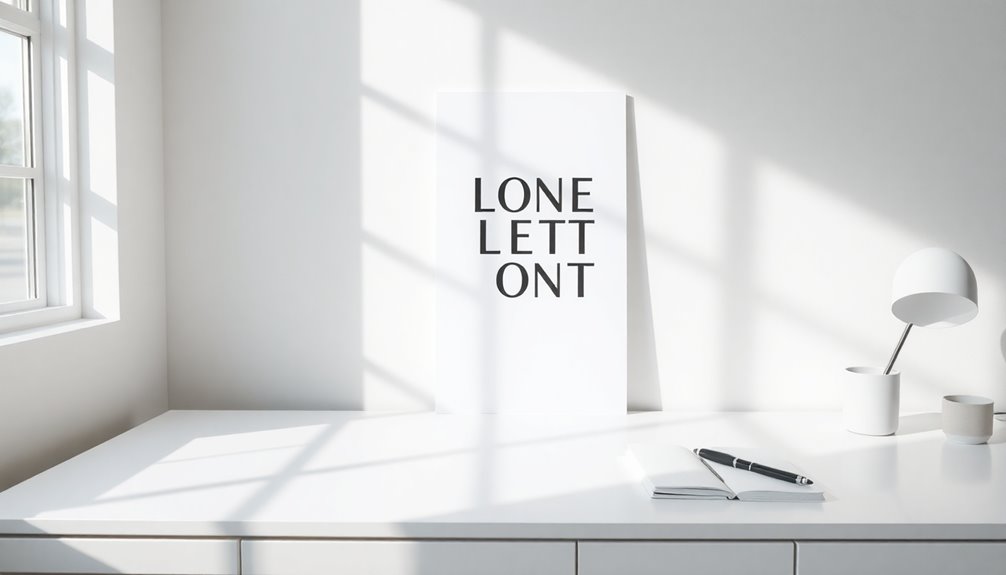
Minimalist typography embodies a clean and functional approach to design.
It's characterized by clean lines and simple strokes, focusing on functionality rather than decorative elements. You'll often see sans-serif fonts used for clarity, emphasizing balance and neutrality. This aligns with current typography trends that prioritize legibility and straightforward communication.
By organizing text effectively, minimalist typography guides you through content while utilizing white space to reduce clutter. This design principle highlights key information, making it easier for you to digest.
Emerging as a reaction to ornate styles of the early 20th century, it draws inspiration from modernist movements like Bauhaus and Swiss Design, proving its enduring appeal in creating impactful designs that resonate with users' preferences for quick, clear communication. Additionally, the use of color palettes in minimalist typography can enhance overall design coherence and visual appeal.
Principles of Minimalist Typography
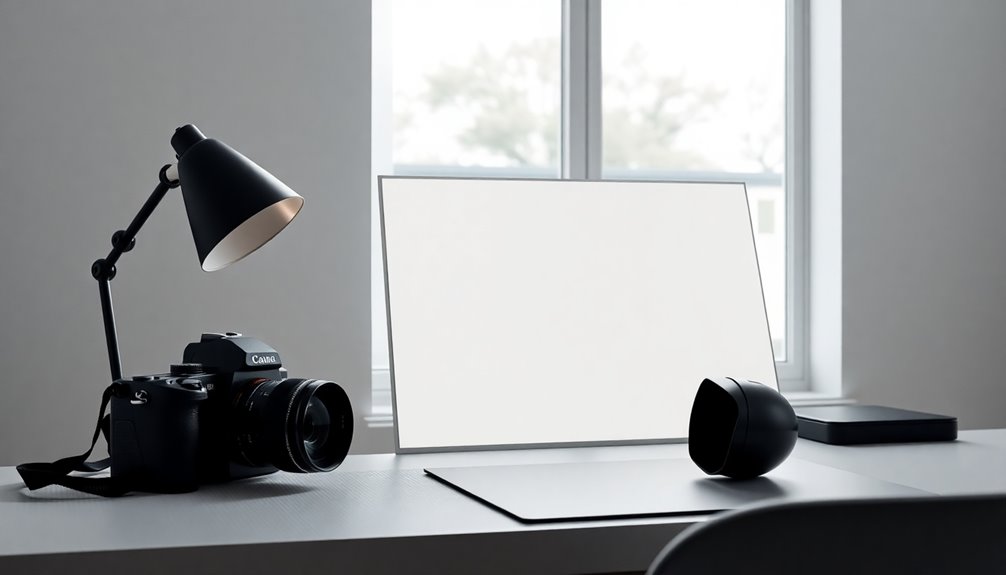
The principles of minimalist typography focus on clarity and simplicity, enabling effective communication through design. This approach prioritizes readability, ensuring your text is easily understood in various sizes and weights.
In minimalist design, ample white space reduces visual clutter, allowing key information to stand out and enhancing user engagement. Typography plays a vital role here; sans-serif fonts are commonly used for their legibility and straightforward communication in both digital and print media.
Organizing your text effectively guides readers through the content, making it easier for them to process and retain information. Ultimately, simplicity is the hallmark of minimalist design principles, emphasizing functionality and clear communication over unnecessary decorative elements. Additionally, color accuracy in typography can enhance the overall visual appeal and effectiveness of your design.
Benefits of Minimalist Typography in Design
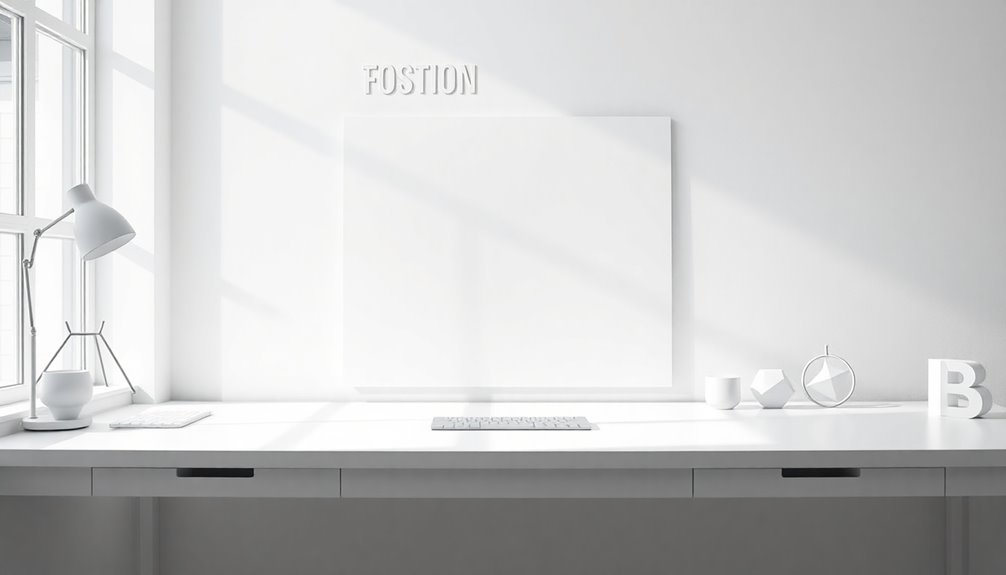
When you embrace minimalist typography in your designs, you enhance the user experience by cutting through the visual noise. This clarity not only improves information retention but also simplifies navigation, making it easier for users to find what they need. Ultimately, you create a more engaging and intuitive interface that resonates with your audience. Additionally, the growing trend in design reflects a broader shift towards wellness tourism as brands seek to promote mindfulness and simplicity in their visual communication.
Enhanced User Experience
While traversing a sea of information, you'll find that minimalist typography enhances user experience by cutting through the clutter. This design trend considerably reduces visual distractions, allowing you to focus on essential content. With clear text hierarchy and ample white space, navigation becomes seamless, making comprehension quicker. The emphasis on legibility guarantees that content is accessible across various devices, catering to all users. Additionally, family-friendly amenities in hotel designs can benefit from minimalist typography, ensuring guests easily locate essential information.
| Benefit | Description | Impact on User Experience |
|---|---|---|
| Reduced Clutter | Less visual noise | Easier focus on key information |
| Clear Hierarchy | Organized text structure | Quicker navigation |
| Enhanced Legibility | Improved readability | Increased accessibility |
| Ample White Space | Breathing room for content | Improved comprehension |
| Intuitive Interfaces | User-friendly design | Positive emotional connections |
Improved Information Retention
Minimalist typography greatly boosts information retention, as it simplifies the way you process and remember content. By reducing visual clutter, this style allows you to focus on essential information, leading to improved retention rates.
Studies reveal that clear and straightforward typography enhances how you process information, resulting in better memory recall.
The ample white space often used with minimalist typography highlights key messages, making them easier to grasp and remember.
Prioritizing legibility and clarity guarantees that your information is readable across various devices, further supporting effective retention.
Research shows that you're more likely to retain information when presented in a simple and organized format, which is a fundamental principle of minimalist design elements. Additionally, site speed plays a crucial role in ensuring that users remain engaged with the content, further enhancing retention.
Simplified Navigation Process
Clear typography not only boosts information retention but also simplifies the navigation process in design. Minimalist typography, characterized by legible sans serifs and ample white space, enhances clarity and readability. This approach helps you quickly grasp layouts and content, reducing frustration and improving user satisfaction. Additionally, the rise of sustainable fashion emphasizes the importance of clear communication in design, as brands aim to convey their eco-friendly practices effectively.
Here's a quick comparison of minimalist typography benefits:
| Benefit | Impact on Navigation | Design Trends |
|---|---|---|
| Clarity | Easier understanding | Modern aesthetics |
| Reduced Clutter | Focus on key info | Clean interfaces |
| Effective Organization | Logical content flow | Intuitive experiences |
Impact of Minimalist Typography on User Experience
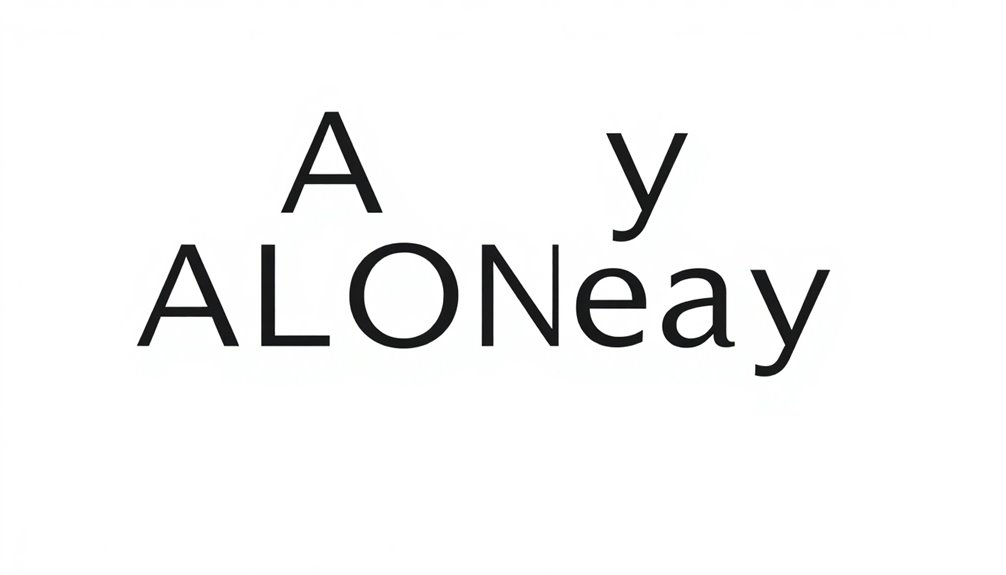
Minimalist typography greatly boosts your reading experience by enhancing clarity and making text easier to digest.
With streamlined navigation, you can move through content efficiently, minimizing frustration.
This approach not only improves legibility but also helps you retain information better across various devices. Additionally, using vetted content ensures that the information presented is reliable and enhances overall comprehension.
Enhanced Readability and Clarity
When you engage with content that prioritizes simplicity and clarity, you quickly notice how much easier it's to read and understand.
Minimalist typography enhances readability by eliminating unnecessary distractions, allowing you to focus on the core message. The ample white space reduces visual clutter, making key information stand out and boosting your overall engagement.
With a design that emphasizes legibility, you can swiftly process and retain information, essential for effective communication. As you navigate through the text, the straightforward approach of minimalist typography fosters a sense of professionalism and trustworthiness, making your experience more enjoyable.
Ultimately, this approach not only improves clarity but also elevates your connection to the content, enriching your user experience. Additionally, just as vibrational alignment can enhance your manifestations, minimalist typography aligns your focus with the essence of the message being conveyed.
Streamlined Navigation and Efficiency
As you navigate through digital content, the streamlined nature of minimalist typography greatly enhances your efficiency. This design trend emphasizes clarity and simplicity, allowing you to focus on essential information without distractions.
With ample white space and clean lines, it notably reduces visual clutter, making text easy to digest on various devices. By simplifying navigation, minimalist typography decreases user frustration, enabling a smoother interaction with digital content.
Studies show that this approach leads to higher information retention rates, which means effective communication is just a glance away. Utilizing modern design tools and technologies, brands can create a polished aesthetic that resonates with today's consumers, fostering positive emotional connections and ensuring a seamless user experience. Additionally, the principles of good grief can be applied to improve emotional processing during digital interactions, enhancing overall user satisfaction.
Challenges and Considerations in Implementing Minimalist Typography

Implementing minimalist typography presents unique challenges that require careful navigation to maintain both clarity and brand identity.
Finding the right balance between simplicity and expressiveness is vital; overly minimalist designs can dilute your brand's emotional connection with the audience.
Striking the perfect harmony between simplicity and expressiveness is essential to maintain your brand's emotional resonance.
Legibility across various devices is another significant hurdle, as different screen sizes and resolutions impact how typography is perceived.
You also need to guarantee accessibility for users with diverse needs, including those with visual impairments, to create an inclusive design environment.
Preserving brand identity while simplifying design involves thoughtful choices in font, color palettes, and overall visual language.
Understanding these design principles is fundamental, as minimalist typography must convey messages effectively without overwhelming viewers. Additionally, designers can draw inspiration from AI online jobs to explore innovative ways to integrate typography in a digital landscape.
Future Trends in Minimalist Typography
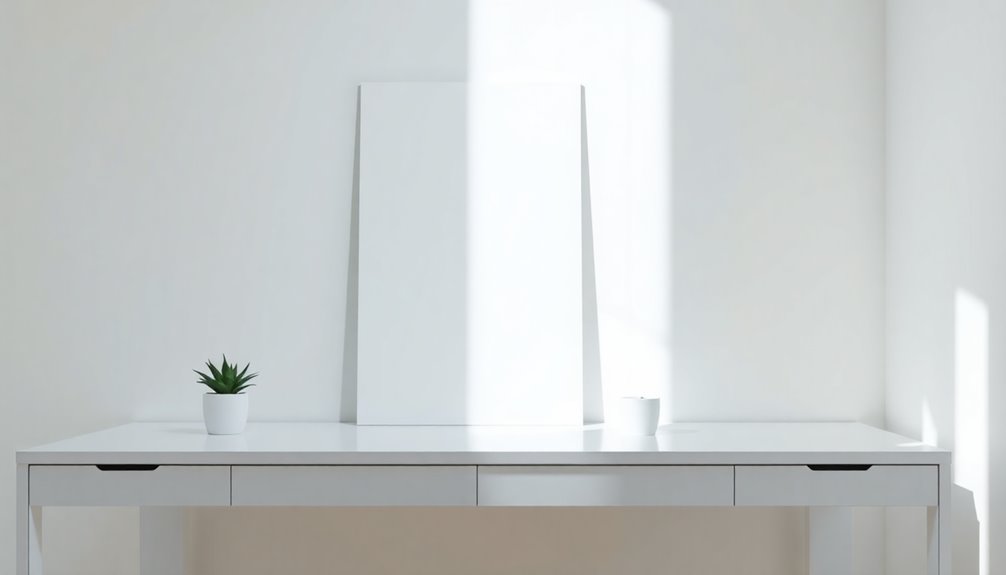
Steering through the challenges of minimalist typography opens the door to exciting future trends that promise to redefine visual communication.
You'll notice a shift toward clean, rounded designs that enhance legibility and visual appeal, aligning with user preferences for simplicity.
Adaptive typography is set to become a key design trend, ensuring readability across various devices and screen sizes.
Sustainability will resonate with minimalist principles, prompting brands to adopt eco-friendly practices without sacrificing typography's simplicity.
As the design landscape evolves, expect experimental approaches that challenge traditional norms, incorporating innovative techniques to captivate audiences.
Ultimately, the enduring legacy of minimalist typography will continue shaping future strategies, emphasizing clarity and straightforward messaging in our complex digital world.
Frequently Asked Questions
How Do I Choose the Right Font for Minimalist Typography?
Choosing the right font for minimalist typography involves focusing on clarity and simplicity.
You'll want to select a typeface that's clean and legible, avoiding overly decorative styles. Stick to a limited number of fonts—ideally one or two—to maintain a cohesive look.
Consider the tone you want to convey; sans-serif fonts often work best for modern designs.
Finally, test your choices in various sizes to guarantee they complement your overall layout effectively.
Can Minimalist Typography Be Used in Branding?
Absolutely, you can use minimalist typography in branding.
It creates a clean and modern look that often resonates well with audiences. When you choose simple fonts, you emphasize clarity and focus, making your brand message stand out.
Just make certain the typography reflects your brand's personality and values. By keeping it straightforward, you enhance recognition and memorability, which are vital for effective branding.
What Are Some Examples of Minimalist Typography in Real Life?
Did you know that 75% of consumers recognize a brand based on its typography alone?
You'll find minimalist typography everywhere in real life. Think of the iconic logos of Apple and Nike; they use simple, clean fonts that resonate with audiences.
Retailers like Muji also showcase minimalist typography in their branding, emphasizing clarity and functionality.
Even public signage often employs this style, making information easy to read and understand at a glance.
Is Minimalist Typography Suitable for All Types of Content?
Minimalist typography isn't suitable for every type of content.
While it works great for clean, modern designs and straightforward messaging, it mightn't convey the complexity or emotion needed in certain contexts, like advertising or storytelling.
If your content requires more personality or detail, you might want to explore other typographic styles.
Ultimately, it's all about aligning your typography with the message and audience you're trying to reach.
How Can I Incorporate Color Into Minimalist Typography?
Imagine a serene landscape, where soft pastels dance gently in the breeze.
To incorporate color into minimalist typography, start with a limited palette—think muted tones that complement your message. Use color sparingly to highlight key words or phrases, creating a focal point.
You can also experiment with transparency, allowing colors to blend seamlessly with your background.
Conclusion
As you explore minimalist typography, you'll find it's more than just a design choice; it's a reflection of clarity in communication. The simplicity not only enhances aesthetic appeal but also considerably improves user experience. Coincidentally, just as you strip away the unnecessary in design, you might discover a similar need in your life—embracing simplicity can lead to greater focus and purpose. So, as you adopt this trend, remember that less can truly be more, both on-screen and off.
